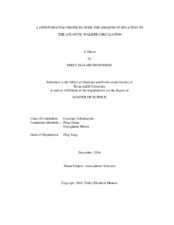| dc.description.abstract | The western rising branch of the local Walker circulation over the Atlantic intensifies
as a result of enhanced convection and the associated latent heat release over the
greater Amazon region. Monthly measurements gathered from 16 years of Tropical Rainfall
Measuring Mission (TRMM) precipitation radar (PR) data are used to construct a
latent heating climatology, which is then compared to those generated by the Convective
and Stratiform Heating (CSH), Spectral Latent Heating (SLH), and variational analysis
algorithms, to determine methodological accuracy. Three-dimensional reflectivity measurements
collected during the Green Ocean Amazon experiment (GOAmazon2014/5) by
the Sistema de Proteção da Amazônia (SIPAM) S-band Doppler radar located in Manaus
in the central Amazon are also used to calculate latent heating profiles, and are compared
to local sounding budgets. While all of the methods show similar seasonal cycles of latent
heating, there are notable differences in the magnitude and height of maximum heating.
Years are then identified as having higher or lower heat release during the Amazon wet
season in boreal spring. Sea-level pressure, sea surface temperature, and surface wind
measurements over the equatorial Atlantic are analyzed to determine the relative effect of
an enhanced rising branch of the Walker circulation using data from Modern-Era Retrospective
analysis for Research and Applications version 2 (MERRA-2). Higher heating
over the Amazon during the wet season generally strengthens the Walker circulation over
the equatorial Atlantic during boreal spring and yields lower surface pressures, stronger
easterlies, and a delayed cold tongue in the equatorial Atlantic during boreal summer. This
work provides observational confirmation of a strong link between Amazonian heating and
the Atlantic Walker circulation, which has implications for improving significant biases in
global climate models over the Amazon and Atlantic and enhancing our understanding of how Amazonian rainfall links to tropical climate variability. | en |


